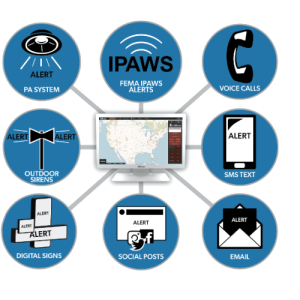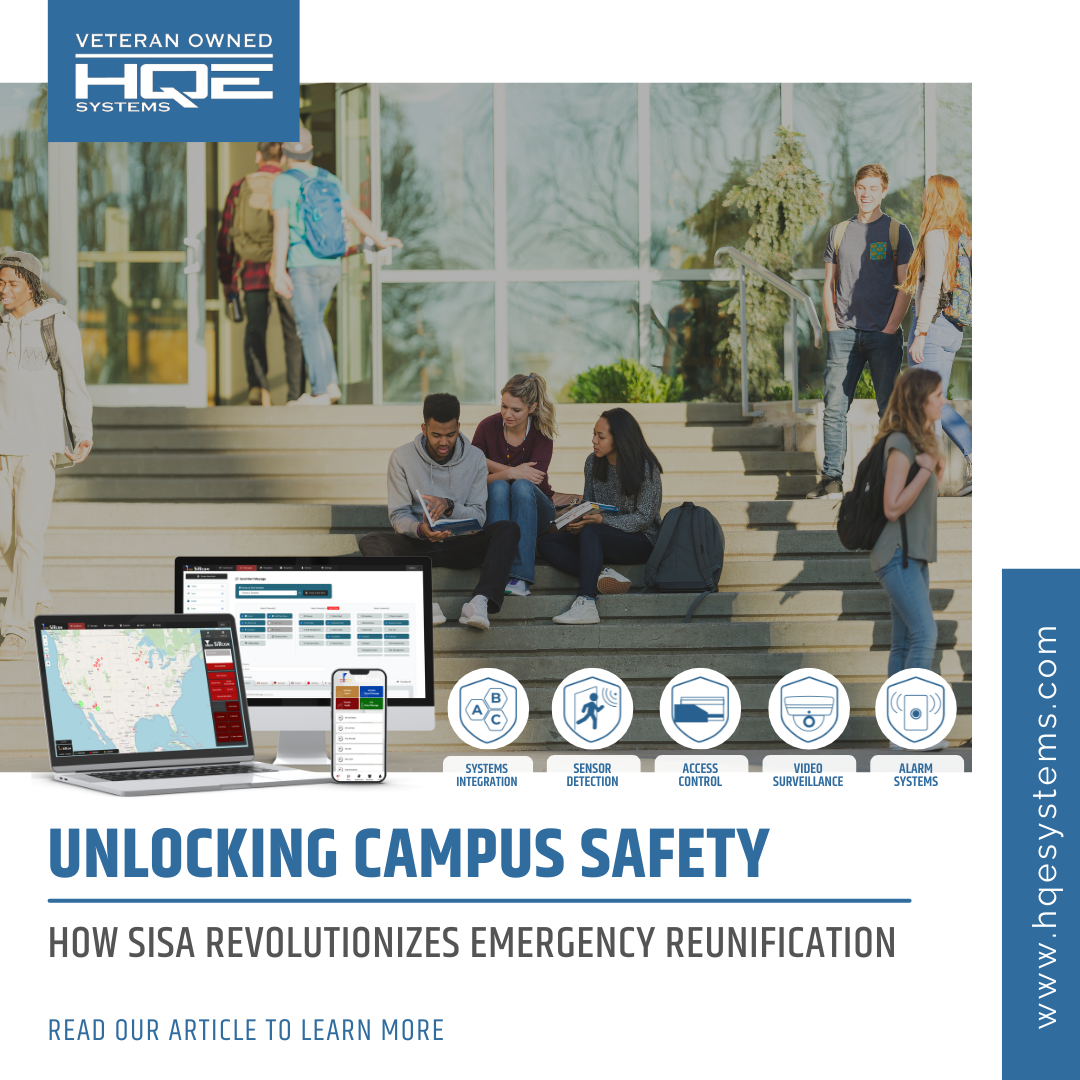Why Reunification Matters: Ensuring Safety in Crisis Situations
Campus safety requires efficient solutions, and reunification is a critical aspect emphasized by industry experts at CSC2024. Ensuring that students, staff, and visitors are quickly and safely brought together during emergencies is essential for maintaining order and reducing panic. However, achieving streamlined reunification involves overcoming significant challenges like communication barriers, coordination logistics, and verification processes. This blog explores these challenges and highlights how HQE Systems’ SiSA (SMART Alert) can enhance campus safety and ensure a swift and efficient reunification process by leveraging advanced technologies.
The Importance of Campus Reunification
What is Campus Reunification?
Campus reunification is the process of reuniting students, staff, and visitors with their families or designated contacts during or after an emergency. This process is crucial for maintaining order and ensuring everyone’s safety. Effective reunification minimizes confusion and ensures that each individual is accounted for and safely returned to their families. It involves coordination between the institution, emergency services, and families to create a smooth and efficient process during crises.
process of reuniting students, staff, and visitors with their families or designated contacts during or after an emergency. This process is crucial for maintaining order and ensuring everyone’s safety. Effective reunification minimizes confusion and ensures that each individual is accounted for and safely returned to their families. It involves coordination between the institution, emergency services, and families to create a smooth and efficient process during crises.
Why is Reunification Critical?
During emergencies such as natural disasters, active shooter situations, or other crises, ensuring that individuals are quickly and safely reunited with their loved ones can significantly reduce trauma and anxiety. Efficient processes also help maintain trust in the institution’s safety protocols and emergency management capabilities.
- Reducing Trauma and Anxiety: Emergencies bring uncertainty and fear. A structured reunification process provides clear guidance, alleviating stress by ensuring everyone knows where to go and what to do.
- Maintaining Order: Structured plans prevent chaos and ensure a calm response during emergencies. Without a clear plan, confusion and disorder can quickly escalate, making the situation more dangerous.
- Enhancing Safety: Reunification prioritizes everyone’s safety on campus, allowing better management of overall security. Quick and efficient processes ensure that individuals are not left vulnerable in unsafe conditions for extended periods.
- Building Trust: Effective emergency handling builds and maintains confidence among parents, guardians, and the community. Trust in an institution’s ability to handle crises is essential for fostering a sense of security.
- Supporting Emergency Management: Efficient reunification aids overall emergency management by allowing responders to focus on managing the crisis. When reunification is handled effectively, emergency personnel can allocate their resources to resolving the emergency.
- Facilitating Communication: Clear and consistent communication is vital during emergencies. An effective reunification plan includes strategies to keep all parties informed about the process and any changes. This helps reduce confusion and ensures everyone knows what to expect.
Campus reunification is vital for any emergency response plan. It ensures the safety and well-being of students, staff, and visitors by reducing trauma, maintaining order, and building trust in the institution’s emergency management capabilities. Addressing the challenges of communication, coordination, and verification is essential for a successful process. Institutions must continuously evaluate and improve their reunification plans to ensure they remain effective in the face of evolving threats and emergencies.
Challenges in Campus Reunification
Communication Barriers
One of the primary challenges in campus reunification is ensuring that accurate information is communicated to all parties involved. During emergencies, communication systems can become overloaded or fail, leading to delays and misinformation. This can cause confusion and panic among students, staff, and parents.
- Overloaded Systems: During large-scale emergencies, communication networks can become congested, making it difficult to disseminate information quickly. The high volume of traffic can slow down or even crash these systems, preventing timely updates from reaching those in need.
- Misinformation: Inaccurate information can spread rapidly, exacerbating the situation and causing unnecessary panic. Rumors and false reports can create additional challenges for emergency responders and campus administrators, who must work to correct these errors while managing the crisis.

Effective communication strategies are essential to overcoming these barriers. Implementing multiple communication channels, such as SMS, email, social media, and public address systems, can help ensure that messages reach their intended recipients. Additionally, regular drills and training can prepare students and staff to respond appropriately when communication systems are strained.
For example, a university might use a combination of text alerts, campus-wide emails, and public address announcements to notify students and staff of an emergency. Regularly practicing these communication methods during drills can help ensure that everyone knows how to respond when an actual emergency occurs.
Coordination and Logistics
Managing the logistics of safely reuniting large groups of people is a daunting task. Ensuring that everyone is accounted for and transported to the designated reunification point requires precise planning and execution. This complexity is heightened when dealing with large campuses or multiple locations.
- Accountability: Keeping track of everyone’s location and ensuring they are safely transported to reunification points can be overwhelming. Accurate attendance records and real-time tracking systems can help manage this aspect more effectively.
- Resource Allocation: Efficiently allocating resources such as transportation and staff to manage the reunification process is critical but challenging. Resources must be strategically positioned and swiftly mobilized to respond to the dynamic needs of the situation.

To address these challenges, institutions can develop comprehensive reunification plans that outline specific roles and responsibilities. These plans should include detailed maps of reunification points, lists of available resources, and protocols for deploying staff and equipment. Regular training and simulations can help ensure that everyone involved understands their role and can execute the plan efficiently.
For instance, a college might conduct regular drills where staff members practice setting up reunification points, checking in students, and coordinating with transportation services. By rehearsing these procedures, staff can become more proficient in managing the logistics of reunification during a real emergency.
Verification Processes
Ensuring that the right individuals are reunited with their designated contacts is crucial to avoid further complications. Manual verification processes can be time-consuming and prone to errors, increasing the risk of misidentification or unauthorized reunification.
- Time-Consuming: Manual processes slow down the reunification efforts, leaving individuals in distress for longer periods. The longer it takes to verify identities and match individuals with their designated contacts, the more stressful and chaotic the situation can become.
- Prone to Errors: Human error can lead to misidentifications, causing further complications and safety concerns. Mistakes in verification can result in individuals being reunited with the wrong people or not being reunited at all.

To mitigate these issues, institutions can implement automated verification systems that use technology such as barcodes, QR codes, or biometric data to quickly and accurately confirm identities. These systems can streamline the verification process, reducing wait times and minimizing the risk of errors. Additionally, having a well-organized and easily accessible database of student and staff information can facilitate faster and more reliable verification.
For example, a school might use a barcode scanning system to quickly check students in and out during reunification. Each student’s ID card could be scanned, and their information cross-referenced with a central database to ensure accurate identification.
Additional Considerations
While communication, coordination, and verification are the primary challenges in campus reunification, there are several other factors that institutions must consider to ensure a successful process.
- Emotional Support: Reunification is not just a logistical challenge; it also requires providing emotional support to those affected by the crisis. Institutions should have counselors and support staff available to help individuals cope with the stress and trauma of the situation.
- Accessibility: Ensuring that reunification plans accommodate individuals with disabilities is essential. This includes providing accessible transportation, clear signage, and assistance for those who may need additional support during the reunification process.
- Cultural Sensitivity: Reunification efforts must be sensitive to the diverse cultural backgrounds of students and staff. This includes providing information in multiple languages and being aware of cultural norms and practices that may impact the reunification process.
- Continuous Improvement: Reunification plans should be continuously evaluated and updated based on feedback from drills, actual emergencies, and changes in campus demographics or infrastructure. Regular reviews and revisions can help ensure that the plans remain effective and relevant.
By addressing the challenges of communication, coordination, and verification, institutions can develop comprehensive and effective reunification plans that prioritize the safety and well-being of students, staff, and visitors. Continuous evaluation and improvement of these plans are essential to ensure they remain relevant and effective in the face of evolving threats and emergencies.
In conclusion, campus reunification is a complex but essential component of emergency response planning. By understanding and addressing the challenges involved, institutions can create safer and more resilient environments for their communities.
How SiSA by HQE Systems Can Help
Overview of SiSA
SiSA (SMART Alert) is a state-of-the-art mass notification system designed to enhance communication and coordination during emergencies. With features such as real-time alerts, multi-channel notifications, and integration capabilities, SiSA is equipped to handle the complexities of campus reunification. This advanced system ensures that information is disseminated quickly and accurately, enabling educational institutions to manage emergencies more effectively.
Key Features of SiSA for Reunification
Real-Time Alerts
SiSA provides instant notifications to all stakeholders, ensuring that everyone is informed about the situation and the steps to be taken. This helps to prevent the spread of misinformation and ensures that everyone receives the same accurate information. Real-time alerts are crucial for maintaining order and reducing panic during emergencies.
Multi-Channel Notifications
The system can send alerts via SMS, email, social media, and other platforms, ensuring comprehensive coverage. This redundancy ensures that even if one communication channel fails, the message will still reach the intended recipients through other means. By leveraging multiple channels, SiSA maximizes the likelihood that important notifications will be received promptly.
SMS, email, social media, and other platforms, ensuring comprehensive coverage. This redundancy ensures that even if one communication channel fails, the message will still reach the intended recipients through other means. By leveraging multiple channels, SiSA maximizes the likelihood that important notifications will be received promptly.
Integration with Existing Systems
SiSA can seamlessly integrate with existing campus security and management systems, enhancing overall efficiency. This integration allows for a more coordinated response and reduces the need for manual intervention. By working with existing infrastructure, SiSA ensures a smoother implementation process and improves overall system functionality.
Automated Verification Processes
SiSA can automate verification processes, ensuring that only authorized individuals are reunited. This reduces the risk of errors and speeds up the reunification process, allowing for quicker and more accurate reunifications. Automated verification enhances security and ensures that reunification is conducted efficiently and safely.
Benefits of Using SiSA for Campus Reunification
Enhanced Communication
SiSA’s real-time alerts and multi-channel notifications ensure that accurate information is disseminated quickly and efficiently. This helps to reduce confusion and panic during emergencies. Clear and consistent communication is vital for ensuring that everyone knows what actions to take and when to take them.
Improved Coordination
The system’s integration capabilities streamline coordination efforts, making the reunification process more manageable. This ensures that everyone involved in the reunification process is working together seamlessly. Improved coordination helps to ensure that resources are allocated effectively and that the process runs smoothly.
Increased Trust and Confidence
By implementing a robust reunification solution, institutions can enhance trust and confidence among students, staff, and parents. Knowing that there is a reliable system in place for reunification can provide peace of mind and reassurance. This trust is crucial for maintaining a positive relationship between the institution and its community, especially during times of crisis.
Efficiency and Speed
The automation of verification processes and the seamless integration with existing systems contribute to a faster and more efficient reunification process. Reducing the time it takes to reunite individuals with their families or designated contacts helps to alleviate stress and ensures that everyone is accounted for as quickly as possible.
Scalability
SiSA is designed to scale with the needs of the institution. Whether managing a small campus or a large university, the system can handle varying levels of complexity and scale accordingly. This flexibility ensures that SiSA can grow with the institution and continue to provide effective reunification support as needs evolve.
In conclusion, SiSA by HQE Systems offers a comprehensive solution for campus reunification, addressing key challenges and enhancing overall safety and efficiency. Its advanced features and benefits make it an invaluable tool for educational institutions seeking to improve their emergency response capabilities and ensure the well-being of their communities during crises.
Advancements in Technology
As technology evolves, so do the capabilities of systems like SiSA. Future advancements in AI, machine learning, and IoT will enhance SiSA’s ability to manage campus safety and reunification processes. These technologies will improve real-time data analysis, predictive analytics, and automated responses, making SiSA an even more powerful tool for ensuring campus safety.
AI and Machine Learning: AI and machine learning will enable SiSA to predict potential threats by analyzing patterns and behaviors, helping to prevent incidents before they occur.
Internet of Things (IoT): IoT devices integrated with SiSA will provide real-time data from campus sensors, enhancing situational awareness for security teams.
Expanding SiSA’s Capabilities
HQE Systems is committed to continuously improving SiSA and expanding its capabilities to address emerging challenges in campus safety. This includes developing new features and integrations to enhance overall effectiveness.
Enhanced Communication Channels: Future updates may include additional communication channels, such as push notifications through dedicated apps, ensuring real-time reach to all stakeholders.
Improved User Interface: Continuous refinement of SiSA’s user interface will make it easier for users to navigate and access critical information during emergencies.
Advanced Analytics: Incorporating sophisticated analytics will provide detailed reports and insights on emergency responses, helping institutions refine their strategies.
Collaboration with Educational Institutions
By working closely with educational institutions, HQE Systems aims to develop tailored solutions that meet the unique needs of each campus. This collaborative approach ensures SiSA remains relevant and effective.
Custom Solutions: HQE Systems customizes SiSA according to the specific safety concerns of each campus.
Feedback and Improvement: Regular feedback from users helps HQE Systems identify areas for enhancement, keeping SiSA updated and effective.
Training and Support: Comprehensive training and support ensure users are well-versed in utilizing SiSA’s features, maximizing its benefits during emergencies.
Commitment to Innovation
HQE Systems is dedicated to staying at the forefront of technological innovation. By investing in research and development, the company ensures that SiSA evolves to meet the changing needs of campus safety.
staying at the forefront of technological innovation. By investing in research and development, the company ensures that SiSA evolves to meet the changing needs of campus safety.
Partnerships and Research: Collaborating with research institutions and technology firms, HQE Systems integrates cutting-edge technology into SiSA, staying ahead of industry trends.
Future-Proofing: Focused on adaptability, SiSA incorporates new features to remain effective in a rapidly changing technological landscape.
In conclusion, the future of campus safety with SiSA looks promising. With advancements in technology, continuous improvements, and a collaborative approach, SiSA is well-positioned to address the evolving challenges of campus safety and reunification. Educational institutions can rely on SiSA to provide comprehensive and effective solutions, ensuring the safety and well-being of their communities.
Building a Safer Future with SiSA
The topic of reunification, highlighted by industry experts at CSC2024, underscores the importance of efficient and effective campus safety solutions. SiSA by HQE Systems offers a comprehensive and robust solution to streamline the reunification process, ensuring the safety and well-being of students, staff, and visitors. By leveraging advanced technologies and best practices, educational institutions can enhance their emergency management capabilities and build trust and confidence among their communities. Implementing SiSA not only addresses current challenges but also prepares institutions for future emergencies, making campuses safer and more resilient.

HQE Systems is a certified Veteran Owned Company. For more information about HQE Systems Inc. and its emergency management, electronic security, and integration solutions, please visit www.hqesystems.com.

Contact: David Ditto (Early Warning Systems Subject Matter Expert)
Email: David.Ditto@hqesystems.com
Phone Number: (843) 872-7020
____________________
HQE Systems, Inc. | HQE is a Minority-Owned Service Disabled Veteran Owned Small Business (SDVOSB) providing full solutions for: Mass Notification Systems, Electronic Security Systems, Software Development Services, Contract Support, and Prototyping Services. As a brand-agnostic solutions provider, HQE prides itself in providing the BEST solution for the project. HQE possesses over 30+ factory certifications and reseller licenses to ensure our clients receive the highest quality service at the ideal budget. HQE can provide full design, installation, integrations, upgrades, and long-term maintenance support for any size and scope project.


